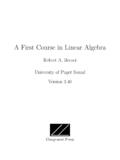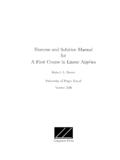Transcription of A First Course in Linear Algebra
1 A First Course in Linear AlgebraRobert A. BeezerUniversity of Puget SoundVersion PressRobert A. Beezer is a Professor of Mathematics at the University of Puget Sound,where he has been on the faculty since 1984. He received a in Mathematics(with an Emphasis in Computer Science) from the University of Santa Clara in 1978,a in Statistics from the University of Illinois at Urbana-Champaign in 1982and a in Mathematics from the University of Illinois at Urbana-Champaignin addition to his teaching at the University of Puget Sound, he has made sabbaticalvisits to the University of the West Indies (Trinidad campus) and the Universityof Western Australia.
2 He has also given several courses in the Master s program atthe African Institute for Mathematical Sciences, South Africa. He has been a Sagedeveloper since teaches calculus, Linear Algebra and abstract Algebra regularly, while his researchinterests include the applications of Linear Algebra to graph theory. His professionalwebsite is at : 978-0-9844175-5-1 Cover DesignAidan MeachamPublisherRobert A. BeezerCongruent PressGig Harbor, Washington, USAc 2004 2015 Robert A. BeezerPermission is granted to copy, distribute and/or modify this document under theterms of the GNU Free Documentation License, Version or any later versionpublished by the Free Software Foundation; with no Invariant Sections, no Front-Cover Texts, and no Back-Cover Texts.
3 A copy of the license is included in theappendix entitled GNU Free Documentation License .The most recent version can always be found my wife, of Linear Equations1 What is Linear Algebra ? ..1 Solving Systems of Linear Equations ..8 Reduced Row-Echelon Form ..22 Types of Solution Sets ..45 Homogeneous Systems of Equations ..58 Nonsingular Matrices ..66 Vectors74 Vector Operations ..74 Linear Combinations ..83 Spanning Sets ..107 Linear Independence ..122 Linear Dependence and Spans ..136 Orthogonality ..148 Matrices162 Matrix Operations ..162 Matrix multiplication .
4 175 Matrix Inverses and Systems of Linear Equations ..193 Matrix Inverses and Nonsingular Matrices ..207 Column and Row Spaces ..217 Four Subsets ..236 Vector Spaces257 Vector Spaces ..257 Subspaces ..272 Linear Independence and Spanning Sets ..288ivBases ..303 Dimension ..318 Properties of Dimension ..331 Determinants340 Determinant of a Matrix ..340 Properties of Determinants of Matrices ..355 Eigenvalues367 Eigenvalues and Eigenvectors ..367 Properties of Eigenvalues and Eigenvectors ..390 Similarity and Diagonalization ..403 Linear Transformations420 Linear Transformations.
5 420 Injective Linear Transformations ..446 Surjective Linear Transformations ..462 Invertible Linear Transformations ..480 Representations501 Vector Representations ..501 Matrix Representations ..514 Change of Basis ..542 Orthonormal Diagonalization ..568 Preliminaries581 Complex Number Operations ..581 Sets ..587 Reference591 Proof Techniques ..591 Archetypes ..605 Definitions ..610 Theorems ..611 Notation ..612 GNU Free Documentation License ..613vPrefaceThis text is designed to teach the concepts and techniques of basic Linear algebraas a rigorous mathematical subject.
6 Besides computational proficiency, there is anemphasis on understanding definitions and theorems, as well as reading, understand-ing and creating proofs. A strictly logical organization, complete and exceedinglydetailed proofs of every theorem, advice on techniques for reading and writing proofs,and a selection of challenging theoretical exercises will slowly provide the novicewith the tools and confidence to be able to study other mathematical topics in arigorous students taking a Course in Linear Algebra will have completed courses indifferential and integral calculus, and maybe also multivariate calculus, and willtypically be second-year students in university.
7 This level of mathematical maturity isexpected, however there is little or no requirement to know calculus itself to use thisbook successfully. With complete details for every proof, for nearly every example,and for solutions to a majority of the exercises, the book is ideal for self-study, forthose of any there is an abundance of guidance in the use of the software system, Sage,there is no attempt to address the problems of numerical Linear Algebra , which arearguably continuous in nature. Similarly, there is little emphasis on a geometricapproach to problems of Linear Algebra .
8 While this may contradict the experience ofmany experienced mathematicians, the approach here is consciously algebraic. As aresult, the student should be well-prepared to encounter groups, rings and fields infuture courses in Algebra , or other areas of discrete to Use This BookWhile the book is divided into chapters, the main organizational unit is the thirty-seven sections. Each contains a selection of definitions, theorems, and examplesinterspersed with commentary. If you are enrolled in a Course , read the sectionbeforeclass and then answer the section s reading questions as preparation for version available for viewing in a web browser is the most complete, integrat-ing all of the components of the book.
9 Consider acquainting yourself with this are indicated by a dashed underlines and will allow you to seamlessly remindyourself of the content of definitions, theorems, examples, exercises, subsections andmore. Use them , mathematics texts have numbered definitions and theorems. Wehave instead adopted a strategy more appropriate to the heavy cross-referencing,linking and knowling afforded by modern media. Mimicking an approach taken byDonald Knuth, we have given items short titles and associated acronyms. You willbecome comfortable with this scheme after a short time, and might even come toappreciate its inherent advantages.
10 In the web version, each chapter has a list of tenor so important items from that chapter, and you will find yourself recognizing someof these acronyms with no extra effort beyond the normal amount of study. BrunoMello suggests that some say an acronym should be pronounceable as a word (suchas radar ), and otherwise is an abbreviation. We will not be so strict in our use ofthe come in three flavors, indicated by the First letter of their label. C indicates a problem that is essentially computational. T represents a problemthat is more theoretical, usually requiring a solution that is as rigorous as a proof.

